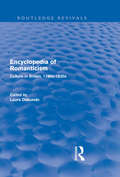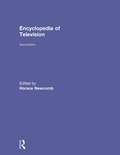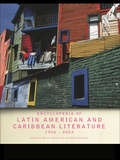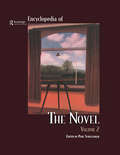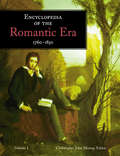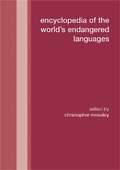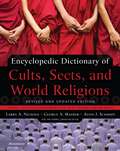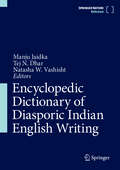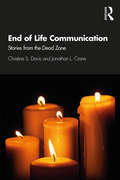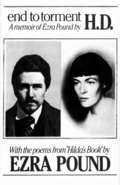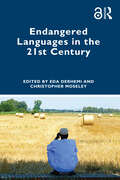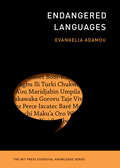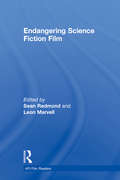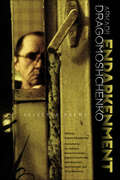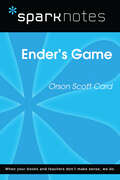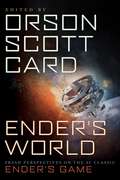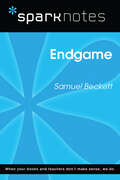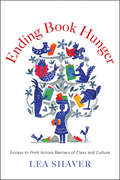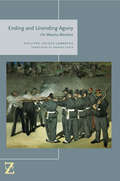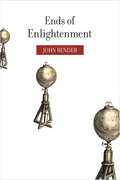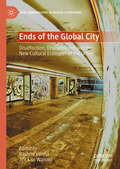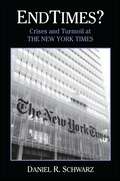- Table View
- List View
Encyclopedia of Romanticism: Culture in Britain, 1780s-1830s (Routledge Revivals)
by Laura DabundoFirst Published in 1992, this encyclopedia is designed to survey the social, cultural and intellectual climate of English Romanticism from approximately the 1780s and the French Revolution to the 1830s and the Reform Bill. Focussing on ‘the spirit of the age’, the book deals with the aesthetic, scientific, socioeconomic – indeed the human – environment in which the Romantics flourished. The books considers poets, playwrights and novelists; critics, editors and booksellers; painters, patrons and architects; as well as ideas, trends, fads, and conventions, the familiar and the newly discovered. The book will be of use for everyone from undergraduate English students, through to thesis-driven graduate students to teaching faculty and scholars.
Encyclopedia of Television
by Horace NewcombThe Encyclopedia of Television, second edtion is the first major reference work to provide description, history, analysis, and information on more than 1100 subjects related to television in its international context.For a full list of entries, contributors, and more, visit the Encyclo pedia of Television, 2nd edition website.
Encyclopedia of Twentieth-Century Latin American and Caribbean Literature, 1900-2003
by Daniel Balderston Mike GonzalezThe Encyclopedia of Twentieth-Century Latin American and Caribbean Literature, 1900–2003 draws together entries on all aspects of literature including authors, critics, major works, magazines, genres, schools and movements in these regions from the beginning of the twentieth century to the present day. With more than 200 entries written by a team of international contributors, this Encyclopedia successfully covers the popular to the esoteric.The Encyclopedia is an invaluable reference resource for those studying Latin American and/or Caribbean literature as well as being of huge interest to those folowing Spanish or Portuguese language courses.
Encyclopedia of the Novel
by Christopher Hudson Paul Schellinger Marijke RijsbermanThe Encyclopedia of the Novel is the first reference book that focuses on the development of the novel throughout the world. Entries on individual writers assess the place of that writer within the development of the novel form, explaining why and in exactly what ways that writer is importnant. Similarly, an entry on an individual novel discusses the importance of that novel not only form, analyzing the particular innovations that novel has introduced and the ways in which it has influenced the subsequent course of the genre. A wide range of topic entries explore the history, criticism, theory, production, dissemination and reception of the novel. A very important component of the Encyclopedia of the Novel is its long surveys of development of the novel in various regions of the world.
Encyclopedia of the Romantic Era, 1760–1850
by Christopher John MurrayIn 850 analytical articles, this two-volume set explores the developments that influenced the profound changes in thought and sensibility during the second half of the eighteenth century and the first half of the nineteenth century. The Encyclopedia provides readers with a clear, detailed, and accurate reference source on the literature, thought, music, and art of the period, demonstrating the rich interplay of international influences and cross-currents at work; and to explore the many issues raised by the very concepts of Romantic and Romanticism.
Encyclopedia of the World's Endangered Languages: Null
by Christopher MoseleyThe concern for the fast-disappearing language stocks of the world has arisen particularly in the past decade, as a result of the impact of globalization. This book appears as an answer to a felt need: to catalogue and describe those languages, making up the vast majority of the world's six thousand or more distinct tongues, which are in danger of disappearing within the next few decades. Endangerment is a complex issue, and the reasons why so many of the world's smaller, less empowered languages are not being passed on to future generations today are discussed in the book's introduction. The introduction is followed by regional sections, each authored by a notable specialist, combining to provide a comprehensive listing of every language which, by the criteria of endangerment set out in the introduction, is likely to disappear within the next few decades. These languages make up ninety per cent of the world's remaining language stocks. Each regional section comprises an introduction that deals with problems of language preservation peculiar to the area, surveys of known extinct languages, and problems of classification. The introduction is followed by a list of all known languages within the region, endangered or not, arranged by genetic affiliation, with endangered and extinct languages marked. This listing is followed by entries in alphabetical order covering each language listed as endangered. Useful maps are provided to pinpoint the more complex clusters of smaller languages in every region of the world. The Encyclopedia therefore provides in a single resource: expert analysis of the current language policy situation in every multilingual country and on every continent, detailed descriptions of little-known languages from all over the world, and clear alphabetical entries, region by region, of all the world's languages currently thought to be in danger of extinction. The Encyclopedia of the World’s Endangered Languages will be a necessary addition to all academic linguistics collections and will be a useful resource for a range of readers with an interest in development studies, cultural heritage and international affairs.
Encyclopedic Dictionary of Cults, Sects, and World Religions: Revised and Updated Edition
by George Mather Alvin J. Schmidt Larry A. NicholsUp-to-date, well-documented, comprehensive coverage of cults, sects, and world religions, from the historical to the contemporary INCLUDES • Well-known groups and world religions, such as Jehovah’s Witnesses, Mormons, Islam, and Baha’i • Groups with a significant North American influence, including Santeria, Rastafarians, Haitian Voodo, white supremacy groups, Wicca, and Satanism REVISED, UPDATED, AND EXPANDED TO INCLUDE NEW ENTRIES AND NEW INFORMATION • Updated information on Islam and its global impact • New entries: the Branch Davidians, Native American religions, Heaven’s Gate, Aum Supreme Truth, the Boston Movement, the Masonic Lodge, and many others • Developments in the world of cults and the occult Encyclopedic Dictionary of Cults, Sects, and World Religions is arguably the most significant reference book on the subject to be published. Formerly titled Dictionary of Cults, Sects, Religions, and the Occult, it provides reliable information on the history and beliefs of nearly every form of religion active today. This extensively revised edition includes new topics, updated information, and a brand-new format for a clearer, more organized approach. The authors evaluate the beliefs and practices of each group from the perspective of the Bible and the historic creeds of the Christian church. You’ll also find group histories, numerous illustrations, charts, current statistics, websites, bibliographies, and other useful information.
Encyclopedic Dictionary of Diasporic Indian English Writing
by Manju Jaidka Tej N. Dhar Natasha W. VashishtThe Handbook of Diasporic Indian Writing in English is an essential reference to Indian literature. It features alphabetical entries of Indian writers who have bridged the gap between cultures and redefined language boundaries. As the field of diasporic writing continues to expand and intersect with various branches of English and Cultural studies, it anticipates a growing market. It offers a unique and compelling perspective on the global tapestry of literature. It draws on various interdisciplinary approaches, including postcolonial theory, cultural studies, and digital humanities, to offer fresh and innovative perspectives on the literature. It is an indispensable resource for research scholars of literary studies and related disciplines, like cultural studies and postcolonial studies.
Encyclopedic Dictionary of Semiotics, Media, and Communication
by Marcel DanesiSemiotics, Media Studies and Communication Studies are three closely interlinked fields. Briefly stated, Semiotics, the science of signs, looks at how humans search for and construct meaning; Communication Studies is concerned with how meaning is conveyed; and Media Studies considers the ways in which messages are transmitted and received. This dictionary is designed to help students and general readers unlock the significance of the terminology and jargon commonly used in these fields.Being interdisciplinary in nature, Semiotics, Media, and Communication Studies are cluttered with notions derived from other disciplines. Hence, this dictionary also encompasses basic concepts from the fields of anthropology, archaeology, psychology, psychoanalysis, linguistics, philosophy, artificial intelligence, computer science, and biology. Collected here are the terms, concepts, personages, schools of thought, and historical movements that appear frequently in the relevant literature.The basis of each entry is a simple definition, which often includes the term's origin. Illustrations are provided where necessary, along with historical sketches of movements or schools of thought. The commentary on personages consists of brief statements about their contribution and relevance. Thus, the dictionary not only defines what a term means, but often goes into its history, applications, and broad implications. Terms are cross-referenced and their etymology is given where possible. This is a compact, practical research manual that will relieve much tension for students in semiotics and related fields. Because of its interdisciplinary approach, it will also provide a range of scholars with a handy reference to disciplines distinct from but related to their own.
End of Life Communication: Stories from the Dead Zone
by Christine S. Davis Jonathan L. CraneThis book examines the dialectic between fictional death as depicted in the media and real death as it is experienced in a hospital setting. Using a Terror Management theoretical lens, Davis and Crane explore the intersections of life and death, experience and fiction, to understand the relationship between them. The authors use complementary perspectives to examine what it means when we speak and think of death as it is conceived in cultural media and as it is constructed by and circulates between patients, health professionals, and supportive family members and friends. Layering analysis with evocative narrative and an intimate tone, with characters, plot, and action that reflect the voices and experiences of all project participants, including the authors’ own, Davis and Crane reflect on what it means to pass away. Their medical humanities approach bridges health communication, cultural studies, and the arts to inform medical ethics and care.
End to Torment: A Memoir of Ezra Pound
by Hilda DoolittleEnd to Torment: A Memoir of Ezra Pound is the deeply personal journal kept by the poet H. D. (Hilda Doolittle. 1886-1961) in 1958, the year Ezra Pound was released from St. Elizabeth's in Washington, D.C., and returned to Italy. H. D., hospitalized in Switzerland from a fall, was urged to put down on paper, once and for all, her memories of Pound, which reached back to 1905, when she was a freshman at Bryn Mawr and he a graduate student at the University of Pennsylvania. They had been engaged for a period, and what began as a brief romance developed into a lifetime's friendship and collaboration in poetry. Throughout the reminiscence runs H. D's conviction that her life and Pound's had been irrevocably entwined since those early days when they had walked together in the Pennsylvania woods and he wrote for her verse after William Morris, Rossetti, Swinburne, and Chaucer. Twenty-five of these poems, handbound in vellum by Pound and called "Hilda's Book," are published here for the first time as an epilogue to this important and moving document.
Endangered Languages
by Sarah G. ThomasonMost of the 7,000 languages spoken in the world today will vanish before the end of this century, taking with them cultural traditions from all over the world, as well as linguistic structures that would have improved our understanding of the universality and variability of human language. This book is an accessible introduction to the topic of language endangerment, answering questions such as: what is it? How and why does it happen? Why should we care? The book outlines the various causes of language endangerment, explaining what makes a language 'safe', and highlighting the danger signs that threaten a minority language. Readers will learn about the consequences of losing a language, both for its former speech community and for our understanding of human language. Illustrated with case studies, it describes the various methods of documenting endangered languages, and shows how they can be revitalised.
Endangered Languages and New Technologies
by Mari C. JonesAt a time when many of the world's languages are at risk of extinction, the imperative to document, analyse and teach them before time runs out is very great. At this critical time new technologies such as visual and aural archiving, digitisation of textual resources, electronic mapping and social media, have the potential to play an integral role in language maintenance and revitalisation. Drawing on studies of endangered languages from around the world - Europe, Asia, Africa and North and South America - this volume considers how these new resources might best be applied, and the problems that they can bring. It also re-assesses more traditional techniques of documentation in light of new technologies and works towards achieving a practicable synthesis of old and new methodologies. This accessible volume will be of interest to researchers in language endangerment, language typology and linguistic anthropology, and to community members working in native language maintenance.
Endangered Languages in the 21st Century
by Christopher Moseley Eda DerhemiEndangered Languages in the 21st Century provides research on endangered languages in the contemporary world, the challenges still to be faced, the work still to be done, and the methods and practices that have come to characterize efforts to revive and maintain disadvantaged indigenous languages around the world. With contributions from scholars across the field, the book brings fresh data and insights to this imperative, but still relatively young, field of linguistics. While the studies acknowledge the threat of losing languages in an unprecedented way, they focus on cases that show resilience and explore paths to sustainable progress. The articles are also intended as a celebration of the 25 years’ work of the Foundation for Endangered Languages, and as a parting gift to FEL’s founder and quarter-century chair, Nick Ostler. This book will be informative for researchers, instructors, and specialists in the field of endangered languages. The book can also be useful for university graduate or undergraduate students, and language activists. The Open Access version of this book, available at www.taylorfrancis.com, has been made available under a Creative Commons Attribution-Non Commercial-No Derivatives 4.0 license.
Endangered Languages: Insights From Endangered Languages (The MIT Press Essential Knowledge series #12)
by Evangelia AdamouA concise, accessible introduction to language endangerment and why it is one of the most urgent challenges of our times.58% of the world’s languages—or, approximately 4,000 languages—are endangered. When we break this figure down, we realize that roughly ten percent of languages have fewer than ten language keepers. And, if one language stops being used every three months, this means that in the next 100 years, if we do nothing, 400 more languages will become dormant. In Endangered Languages, Evangelia Adamou, a specialist of endangered languages and a learner of her own community language, Nashta, offers a sobering look at language endangerment and what is truly lost when a language disappears from usage.Combining recent advances from the Western scientific tradition—from the fields of linguistics, psycholinguistics, neurolinguistics, language attrition, population genetics, and natural language processing—and insights from Indigenous epistemology, theory, and ethics, Adamou examines a wealth of issues surrounding endangered languages. She discusses where endangered languages are found, including how they are faring in a digital world, why these languages are no longer used, and how communities can reclaim languages and keep them strong. Adamou also explains the impact of language continuity on community and individual health and well-being, the importance of language transmission in cultural transmission, and why language rights are essentially human rights.Drawing on varied examples from the Wampanoag Nation to Wales, Endangered Languages offers a powerful reminder of the crucial role every language has in the vitality and well-being of individuals, communities, and our world.
Endangering Science Fiction Film (AFI Film Readers)
by Sean Redmond Leon MarvellEndangering Science Fiction Film explores the ways in which science fiction film is a dangerous and endangering genre. The collection argues that science fiction's cinematic power rests in its ability to imagine ‘Other’ worlds that challenge and disturb the lived conditions of the ‘real’ world, as it is presently known to us. From classic films such as 2001: A Space Odyssey and Solaris to modern blockbusters including World War Z and Gravity, and directors from David Cronenberg to Alfonso Cuarón, contributors comment on the way science fiction film engages with dangerous encounters, liminal experiences, sublime aesthetics, and untethers space and time to question the very nature of human existence. With the analysis of a diverse range of films from Europe, Asia, North and South America, Endangering Science Fiction Film offers a uniquely interdisciplinary view of the evolving and dangerous sentiments and sensibility of this genre.
Endarkenment: Selected Poems (Wesleyan Poetry Series)
by Arkadii DragomoshchenkoThe poet Arkadii Dragomoshchenko made his debut in underground magazines in the late Soviet period, and developed an elliptic, figural style with affinities to Moscow metarealism, although he lived in what was then Leningrad. Endarkenment brings together revisions of selected translations by Lyn Hejinian and Elena Balashova from his previous American titles, long out of print, with translations of new work carried out by Genya Turovskaya, Bela Shayevich, Jacob Edmond, and Eugene Ostashevsky. This chronological arrangement of Dragomoshchenko's writing represents the heights of his imaginative poetry and fragmentary lyricism from perestroika to the time of his death. His language—although "perpetually incomplete" and shifting in meaning—remains fresh and transformative, exhibiting its roots in Russian Modernism and its openness to the poet's Language School contemporaries in the United States. The collection is a crucial English introduction to Dragomoshchenko's work. It is also bilingual, with Russian texts that are otherwise hard to obtain. It also includes a foreword by Lyn Hejinian, an essay on how the poetry reads in Russian, a biography, and a list of publications. Check for the online reader's companion at endarkenment.site.wesleyan.edu.
Ender's Game (SparkNotes Literature Guide Series)
by SparkNotesEnder's Game (SparkNotes Literature Guide) by Orson Scott Card Making the reading experience fun! Created by Harvard students for students everywhere, SparkNotes is a new breed of study guide: smarter, better, faster.Geared to what today's students need to know, SparkNotes provides:chapter-by-chapter analysis explanations of key themes, motifs, and symbols a review quiz and essay topics Lively and accessible, these guides are perfect for late-night studying and writing papers.
Ender's World: Fresh Perspectives on the SF Classic Ender's Game
by Janis Ian Aaron JohnstonExperience the thrill of reading Ender's Game all over again Go deeper into the complexities of Orson Scott Card's classic novel with science fiction and fantasy writers, YA authors, military strategists, including: Ender prequel series coauthor Aaron Johnston on Ender and the evolution of the child hero Burn Notice creator Matt Nix on Ender's Game as a guide to life Hugo award–winning writer Mary Robinette Kowal on how Ender's Game gets away with breaking all the (literary) rules Retired US Air Force Colonel Tom Ruby on what the military could learn from Ender about leadership Bestselling YA author Neal Shusterman on the ambivalence toward survival that lies at the heart of Ender's story Plus pieces by: Hilari Bell John Brown Mette Ivie Harrison Janis Ian Alethea Kontis David Lubar and Alison S. Myers John F. Schmitt Ken Scholes Eric James Stone Also includes never-before-seen content from Orson Scott Card on the writing and evolution of the events in Ender's Game, from the design of Battle School to the mindset of the pilots who sacrificed themselves in humanity's fight against the formics
Endgame (SparkNotes Literature Guide Series)
by SparkNotesEndgame (SparkNotes Literature Guide) by Samuel Beckett Making the reading experience fun! Created by Harvard students for students everywhere, SparkNotes is a new breed of study guide: smarter, better, faster.Geared to what today's students need to know, SparkNotes provides:chapter-by-chapter analysis explanations of key themes, motifs, and symbols a review quiz and essay topics Lively and accessible, these guides are perfect for late-night studying and writing papers.
Ending Book Hunger: Access to Print Across Barriers of Class and Culture
by Lea ShaverAn eye-opening exploration of “book hunger”—the unmet need for books in underserved communities—and efforts to universalize access to print Worldwide, billions of people suffer from book hunger. For them, books are too few, too expensive, or do not even exist in their languages. Lea Shaver argues that this is an educational crisis: the most reliable predictor of children’s achievement is the size of their families’ book collections. <P><P>This book highlights innovative nonprofit solutions to expand access to print. First Book, for example, offers diverse books to teachers at bargain prices. Imagination Library mails picture books to support early literacy in book deserts. Worldreader promotes mobile reading in developing countries by turning phones into digital libraries. Pratham Books creates open access stories that anyone may freely copy, adapt, and translate. <P><P>Can such efforts expand to bring books to the next billion would-be readers? Shaver reveals the powerful roles of copyright law and licensing, and sounds the clarion call for readers to contribute their own talents to the fight against book hunger.
Ending and Unending Agony: On Maurice Blanchot (Lit Z)
by Philippe Lacoue-LabarthePublished posthumously, Ending and Unending Agony is Philippe Lacoue-Labarthe’s only book entirely devoted to the French writer and essayist Maurice Blanchot (1907–2003). The place of Blanchot in Lacoue-Labarthe’s thought was both discreet and profound, involving difficult, agonizing questions about the status of literature, with vast political and ethical stakes.Together with Plato, Holderlin, Nietzsche, Benjamin, and Heidegger, Blanchot represents a decisive crossroads for Lacoue-Labarthe’s central concerns. In this book, they converge on the question of literature, and in particular of literature as the question of myth—in this instance, the myth of the writer born of the autobiographical experience of death.However, the issues at stake in this encounter are not merely autobiographical; they entail a relentless struggle with processes of figuration and mythicization inherited from the age-old concept of mimesis that permeates Western literature and culture. As this volume demonstrates, the originality of Blanchot’s thought lies in its problematic but obstinate deconstruction of precisely such processes.In addition to offering unique, challenging readings of Blanchot’s writings, setting them among those of Montaigne, Rousseau, Freud, Winnicott, Artaud, Bataille, Lacan, Malraux, Leclaire, Derrida, and others, this book offers fresh insights into two crucial twentieth-century thinkers and a new perspective on contemporary debates in European thought, criticism, and aesthetics.
Ends of Enlightenment
by John BenderEnds of Enlightenment explores three realms of eighteenth-century European innovation that remain active in the twenty-first century: the realist novel, philosophical thought, and the physical sciences, especially human anatomy. The European Enlightenment was a state of being, a personal stance, and an orientation to the world. Ways of probing experience and knowledge in the novel and in the visual arts were interleaved with methods of experimentation in science and philosophy. This book's fresh perspective considers the novel as an art but also as a force in thinking. The critical distance afforded by a view back across the centuries allows Bender to redefine such novelists as Defoe, Fielding, Goldsmith, Godwin, and Laclos by placing them along philosophers and scientists like Newton, Locke, and Hume but also alongside engravings by Hogarth and by anatomist William Hunter. His book probes the kinship among realism, hypothesis, and scientific fact, defining in the process the rhetorical basis of public communication during the Enlightenment.
Ends of the Global City: Disaffection, Displacement and the New Cultural Ecologies of the Urban (New Comparisons in World Literature)
by Jini Kim Watson Rashmi VarmaThis volume of essays explores how the global city is confronting new forms of crises and disruption. Examining cities in the Caribbean, North America, Africa, the Persian Gulf, Asia and Australia, the essays use literary and cultural analysis to examine the pasts, present and futures of the global city. Ranging from the period of high postcolonial development, industrialization and compacted modernization to present-day neoliberal urban planning, the collection considers arrivals and departures in the global city, offering new critical vocabularies to analyse ongoing processes of migration, economic immiseration, and environmental collapse.
Endtimes?: Crises and Turmoil at the New York Times (Excelsior Editions)
by Daniel R. SchwarzFrom false stories about weapons of mass destruction in Iraq to growing competition from online and twenty-four-hour cable news, the first decade of the twenty-first century was not particularly kind to the New York Times. In this groundbreaking study of the recent life and times of America's most important newspaper, Daniel R. Schwarz describes the transformation of the Times as it has confronted not only its various scandals and embarrassments but also the rapid rise of the internet and blogosphere, the ensuing decline in circulation and print advertising, and the change in what contemporary readers want and how they want to get it.Drawing on more than forty one-on-one interviews with past and present editors (including every living executive editor), senior figures on the business and financial side, and publisher Arthur Sulzberger Jr., Schwarz discusses virtually every aspect of the contemporary Times, from columnists to cultural coverage. He explains how, in response to continuous online updating and twenty-four-hour all-news radio and television, the Times has become much more like a daily magazine than a traditional newspaper, with increased analysis (as opposed to reporting) of the news as well as value-added features on health, travel, investing, and food.After carefully tracing the rise of the Times's website, Schwarz asks whether the Times can survive as a print newspaper, whether it can find a business model to support its vast print and online newsgathering operation, and whether the Sulzberger family can survive as controlling owners. He also asks whether the Times, in its desperate effort to survive, has abandoned its quality standards by publishing what he calls "Timeslite" and "Timestrash."Writing as a skeptical outsider and devoted lifelong reader, Schwarz concludes that the Times is the worst newspaper in the world—except for all the others. Endtimes? is a must-read for Times readers as well as anyone interested in the radical change in print and broadcast media in the rapidly evolving Internet Age.
